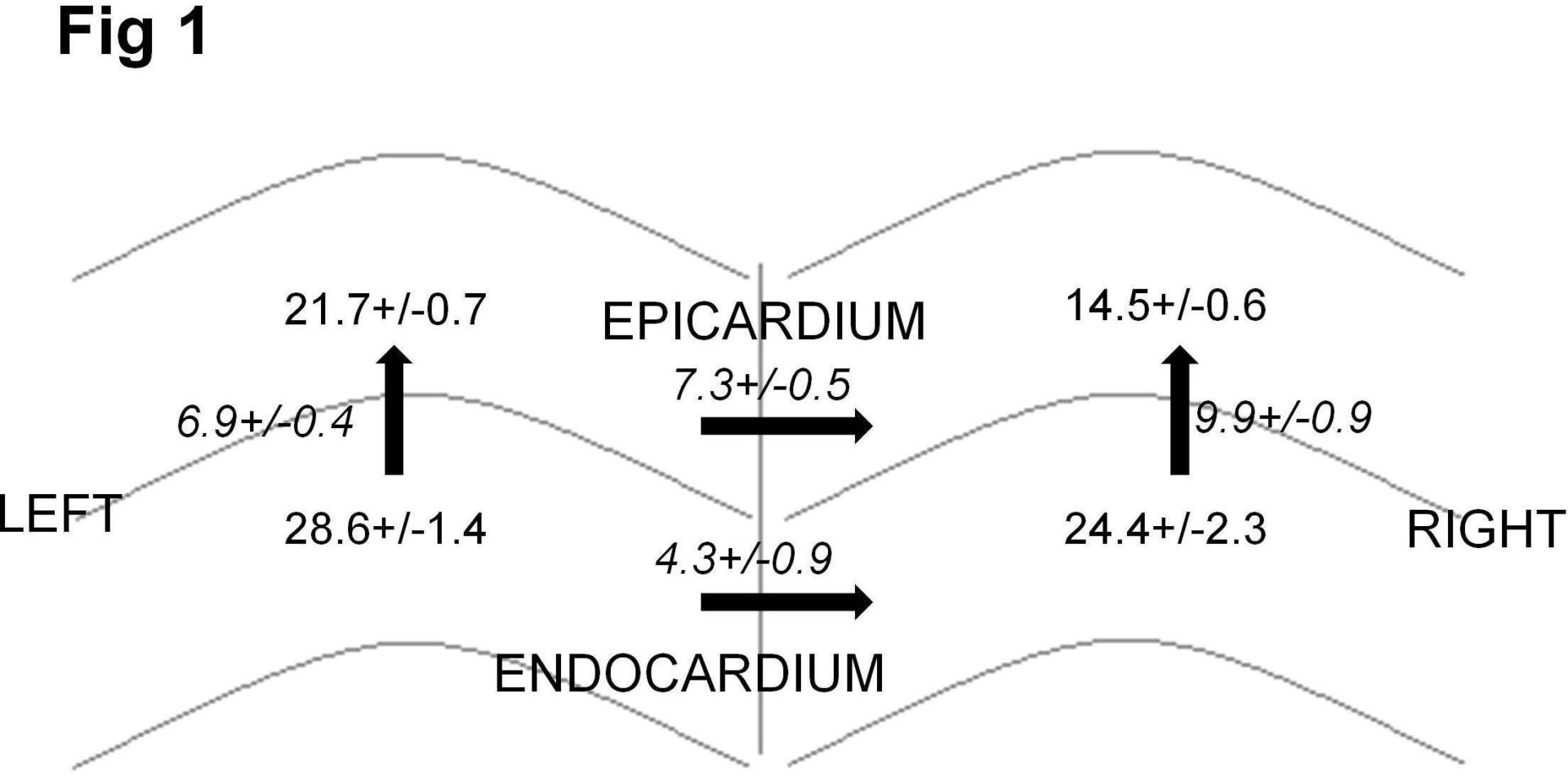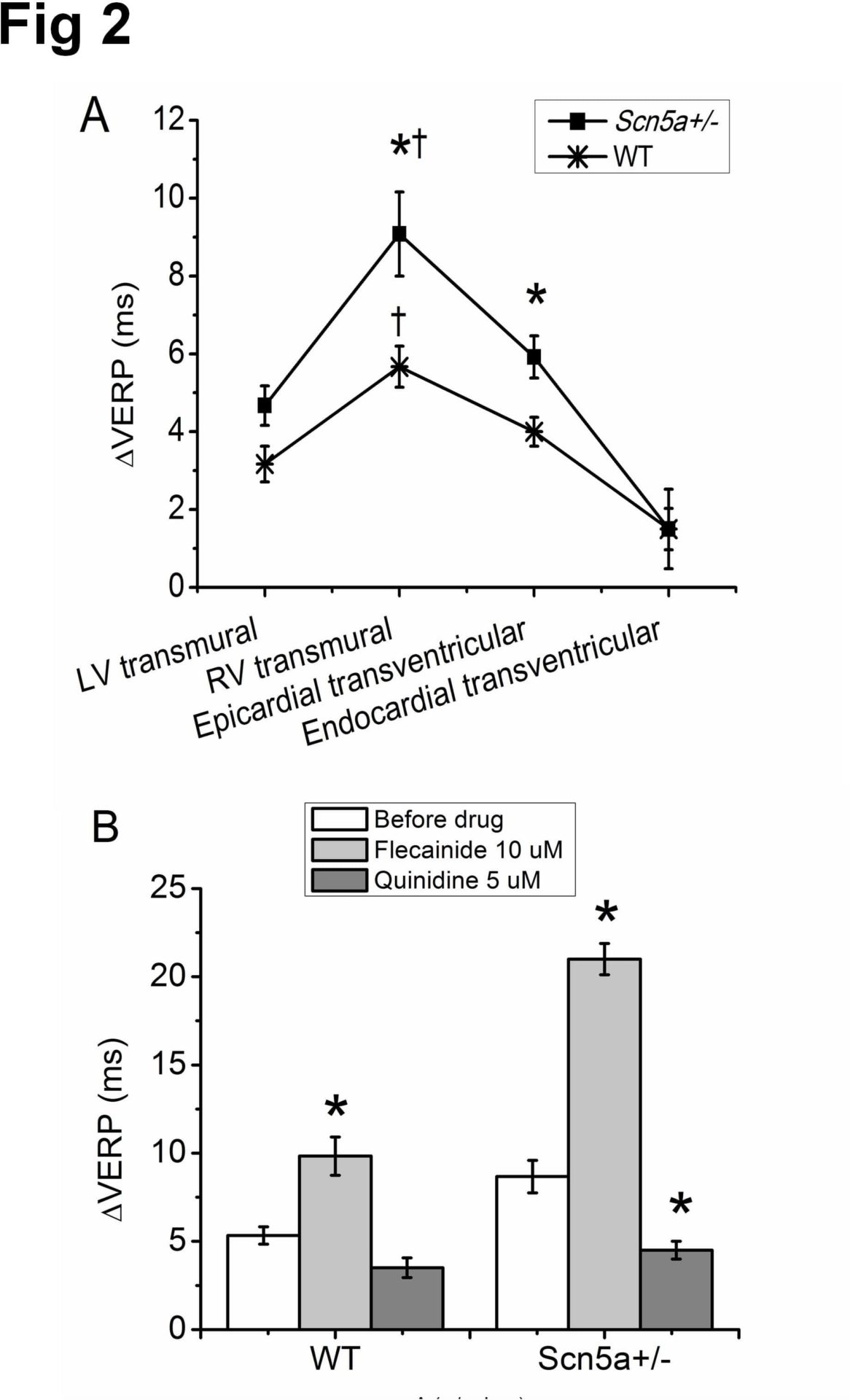Recent experiments have implicated accentuated right ventricular (RV) transmural repolarization gradients in arrhythmogenesis in Brugada Syndrome (1). The present experiments investigated for the first time the involvement of heterogeneities in the corresponding ventricular effective refractory periods (VERP), hitherto assumed to vary in concert with action potential duration (APD) (2). VERPs and APDs were compared in the RV and LV, epicardial and endocardial, regions of Langendorff-perfused wild-type (WT) and loss of function Scn5a+/- murine hearts. APDs were obtained from monophasic action potential recordings (3) during regular pacing and VERPs from a programmed S1S2 protocol, before and following addition of flecainide or quinidine. VERP dispersions were calculated from the difference in VERP between neighbouring cardiac regions (Fig 1). Differences in APDs and VERPs were analyzed using Student’s T-tests with a modified Bonferroni correction factor. In contrast to APD values, Scn5a+/- hearts showed longer VERPs than WT (37.0 +/- 1.1 ms to 39.9 +/- 0.9 ms (n=12), p=0.04 for RV epicardium). Both showed shorter VERPs in RV than LV epicardium and in the epicardia than endocardia of both LV and RV (eg 49.0 +/- 1.9 ms in RV endocardium vs 39.9 +/- 0.9 ms in RV epicardium for Scn5a+/- (n=12), p=0.01). VERP/APD ratios were consistently larger in Scn5a+/- than WT but did not vary significantly between regions, contrasting with expectations from re-entrant arrhythmogenic mechanisms suggested previously for the gain of function, Scn5aΔ/+ genotype. However, Scn5a+/- hearts showed greater VERP dispersions, particularly across the RV, than WT (Fig 2A) (9.1 +/- 1.1 ms vs 5.7 +/- 0.5 ms (n=12), p=0.009). Both flecainide and quinidine increased the regional VERP values particularly in Scn5a+/-. However, flecainide increased but quinidine decreased the VERP dispersions, particularly across the RV in the Scn5a+/- (Fig 2B) (8.7 +/- 0.9 ms before drug to 21.0 +/- 0.9 ms with flecainide (p<0.001), and to 4.5 +/- 0.5 ms with quinidine (p=0.003) (n=12)). This is in direct parallel with established pro- and anti-arrhythmic effects of flecainide and quinidine in Scn5a+/-. These findings implicate for the first time an involvement of VERP dispersions in the RV in the arrhythmogenesis found in murine Scn5a+/- hearts. This may contribute to future work investigating possible pharmacological treatments for a disease for which the current mainstay of treatment is ICD implantation.
University of Manchester (2010) Proc Physiol Soc 19, C8
Oral Communications: Dispersion of Refractoriness Promotes Arrhythmogenesis in a Murine Model of Brugada Syndrome
C. A. Martin1, A. A. Grace2, C. L. Huang1
1. Physiological Laboratory, University of Cambridge, Cambridge, United Kingdom. 2. Department of Biochemistry, University of Cambridge, Cambridge, United Kingdom.
View other abstracts by:
Fig 1. Four chambers of a typical Scn5a+/- heart are displayed diagramatically: left epicardium, right epicaridum, left endocardium and right endocardium, with their respective VERP values in normal font. Arrows between the four areas depict the gradients between them, with ΔVERP values in italic font. Data are expressed as mean +/- SEM. Thus the gradients are calculated: LV transmural = LV endocardial APD - LV epicardial APD, RV transmural = RV endocardial APD - RV epicardial APD, Epicardial transventricular = LV epicardial APD - RV epicardial APD, Endocardial transventricular = LV endocardial APD - RV endocardial APD.
Fig 2.(A) ΔVERP in four cardiac regions; n=12 for both WT and Scn5a+/-. T-tests between WT and Scn5a+/- values, have significant values denoted by *; T-tests between cardiac regions within WT and Scn5a+/- hearts have significance denoted by †. (B) ΔVERP across the RV before and after exposure to flecainide or quinidine; n=12 prior to drug and n = 6 in all cases following drug. T-tests comparing values before and after drug between have significant values denoted by *.
Where applicable, experiments conform with Society ethical requirements.


